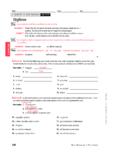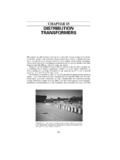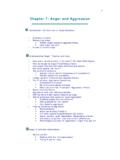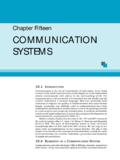Transcription of Chapter 4 Rehabilitation - World Health …
1 Chapter 4. Rehabilitation Being an amputee myself with functional lower limb prosthetics, I can say that the device enable me to function normally. My prosthetics brought back my confidence and self esteem to participate in mainstream activities of the society, thus changing my outlook in life to positive to more positive. Definitely, my prosthetics had an impact on my present status or the quality of life I am enjoying now because I basically perform all the task that is assigned to me which at the end the day results to quality output and good pay.. Johnny Coming from a country where there is not much awareness and resources for dealing with post-spinal cord injured victims, my return home was indeed an enormous chal- lenge. Living in a house that was inaccessible, members of my family have had to perse- vere with daily lifting me up and down the house. Physiotherapy had become a crucial necessity and as a result of the continuous costs incurred, my mother took up the task to administer physiotherapy as well as stand in as my caretaker.
2 During my Rehabilitation process, getting admitted for treatment during times of illness or to use physiotherapy facilities was close to impossible as a result of the overwhelming numbers on the waiting list. My Rehabilitation period despite challenging was a humbling moment of my life and a continuous process that I face until today. I have learned disability is not inability and a strong mentality and great attitude have been very important! . Casey Families find themselves in difficulty after a member of the family has a stroke. I. consider myself a stroke survivor but my family are stroke victims. I have been fortunate and have been able to return to work, but I have had to battle all the way. We do not get the help we need, services are so variable and there is not enough speech and language therapy and physiotherapy. After my stroke I had to learn to do everything again, includ- ing swallowing and to learn to talk. The first thing that came back to me with my speech was swearing, my first sentence had four expletives in it, but I am told that was normal.
3 Linda If you don't have a proper wheelchair, that is when you really feel that you are disa- bled. But if you have a proper wheelchair, which meets your needs and suits you, you can forget about your disability.. Faustina 4. Rehabilitation Rehabilitation has long lacked a unifying conceptual framework (1). Historically, the term has described a range of responses to disability, from interventions to improve body function to more comprehensive measures designed to promote inclusion (see Box ). The International Classification of Functioning, Disability and Health (ICF) provides a framework that can be used for all aspects of Rehabilitation (11 14). For some people with disabilities, Rehabilitation is essential to being able to participate in education, the labour market, and civic life. Rehabilitation is always voluntary, and some individuals may require support with decision-making about Rehabilitation choices. In all cases Rehabilitation should help to empower a person with a disability and his or her family.
4 Article 26, Habilitation and Rehabilitation , of the United Nations Convention on the Rights of Persons with Disabilities (CRPD) calls for: appropriate measures, including through peer support, to enable persons with disabilities to attain and maintain their maximum independence, full physical, mental, social and vocational ability, and full inclusion and participation in all aspects of life . The Article further calls on countries to organize, strengthen, and extend comprehensive Rehabilitation services and programmes, which should begin as early as possible, based on multidisciplinary assessment of individual needs and strengths, and including the provision of assistive devices and technologies. This Chapter examines some typical Rehabilitation measures, the need and unmet need for Rehabilitation , barriers to accessing Rehabilitation , and ways in which these barriers can be addressed. Understanding Rehabilitation Rehabilitation measures and outcomes Rehabilitation measures target body functions and structures, activities and participation, environmental factors, and personal factors.
5 They contribute 95. World report on disability Box What is Rehabilitation ? This Report defines Rehabilitation as a set of measures that assist individuals who experience, or are likely to experience, disability to achieve and maintain optimal functioning in interaction with their environments . A distinction is sometimes made between habilitation, which aims to help those who acquire disabilities con- genitally or early in life to develop maximal functioning; and Rehabilitation , where those who have experienced a loss in function are assisted to regain maximal functioning (2). In this Chapter the term Rehabilitation covers both types of intervention. Although the concept of Rehabilitation is broad, not everything to do with disability can be included in the term. Rehabilitation targets improvements in individual functioning say, by improving a person's ability to eat and drink independently. Rehabilitation also includes making changes to the individual's environment for example, by installing a toilet handrail.
6 But barrier removal initiatives at societal level, such as fitting a ramp to a public building, are not considered Rehabilitation in this Report. Rehabilitation reduces the impact of a broad range of Health conditions. Typically Rehabilitation occurs for a specific period of time, but can involve single or multiple interventions delivered by an individual or a team of Rehabilitation workers, and can be needed from the acute or initial phase immediately following recognition of a Health condition through to post-acute and maintenance phases. Rehabilitation involves identification of a person's problems and needs, relating the problems to relevant factors of the person and the environment, defining Rehabilitation goals, planning and implementing the measures, and assessing the effects (see figure below). Educating people with disabilities is essential for developing knowledge and skills for self-help, care, management, and decision-making.
7 People with disabilities and their families experi- ence better Health and functioning when they are partners in Rehabilitation (3 9). The Rehabilitation process Identify problems and needs Relate problems Assess effects to modifiable and limiting factors Define target problems Plan, implement, and and target mediators, coordinate interventions select appropriate measures Source: A modified version of the Rehabilitation Cycle from (10). Rehabilitation provided along a continuum of care ranging from hospital care to Rehabilitation in the com- munity (12) can improve Health outcomes, reduce costs by shortening hospital stays (15 17), reduce disability, and improve quality of life (18 21). Rehabilitation need not be expensive. Rehabilitation is cross-sectoral and may be carried out by Health professionals in conjunction with specialists in education, employment, social welfare, and other fields. In resource-poor contexts it may involve non-specialist work- ers for example, community-based Rehabilitation workers in addition to family, friends, and community groups.
8 Rehabilitation that begins early produces better functional outcomes for almost all Health conditions associated with disability (18 30). The effectiveness of early intervention is particularly marked for children with, or at risk of, developmental delays (27, 28, 31, 32), and has been proven to increase educational and developmental gains (4, 27). 96. Chapter 4 Rehabilitation to a person achieving and maintaining optimal maintaining relationships. Rehabilitation functioning in interaction with their environ- might mean drug treatment, education of ment, using the following broad outcomes: patients and families, and psychological prevention of the loss of function support via outpatient care, community- slowing the rate of loss of function based Rehabilitation , or participation in a improvement or restoration of function support group. compensation for lost function A child who is deafblind. Parents, teachers, maintenance of current function.
9 Physical and occupational therapists, and other orientation and mobility specialists Rehabilitation outcomes are the benefits need to work together to plan accessible and and changes in the functioning of an individ- stimulating spaces to encourage develop- ual over time that are attributable to a single ment. Caregivers will need to work with the measure or set of measures (33). Traditionally, child to develop appropriate touch and sign Rehabilitation outcome measures have focused communication methods. Individualized on the individual's impairment level. More education with careful assessment will help recently, outcomes measurement has been learning and reduce the child's isolation. extended to include individual activity and participation outcomes (34, 35). Measurements Limitations and restrictions for a child of activity and participation outcomes assess with cerebral palsy, and possible Rehabilitation the individual's performance across a range measures, outcomes, and barriers are described of areas including communication, mobility, in Table self-care, education, work and employment, Rehabilitation teams and specific disci- and quality of life.
10 Activity and participa- plines may work across categories. Rehabilita- tion outcomes may also be measured for tion measures in this Chapter are broadly programmes. Examples include the number divided into three categories: of people who remain in or return to their Rehabilitation medicine home or community, independent living rates, therapy return-to-work rates, and hours spent in lei- assistive technologies. sure and recreational pursuits. Rehabilitation outcomes may also be measured through Rehabilitation medicine changes in resource use for example, reduc- ing the hours needed each week for support Rehabilitation medicine is concerned with and assistance services (36). improving functioning through the diagnosis The following examples illustrate different and treatment of Health conditions, reduc- Rehabilitation measures: ing impairments, and preventing or treating A middle-aged woman with advanced complications (12, 37). Doctors with specific diabetes.
















